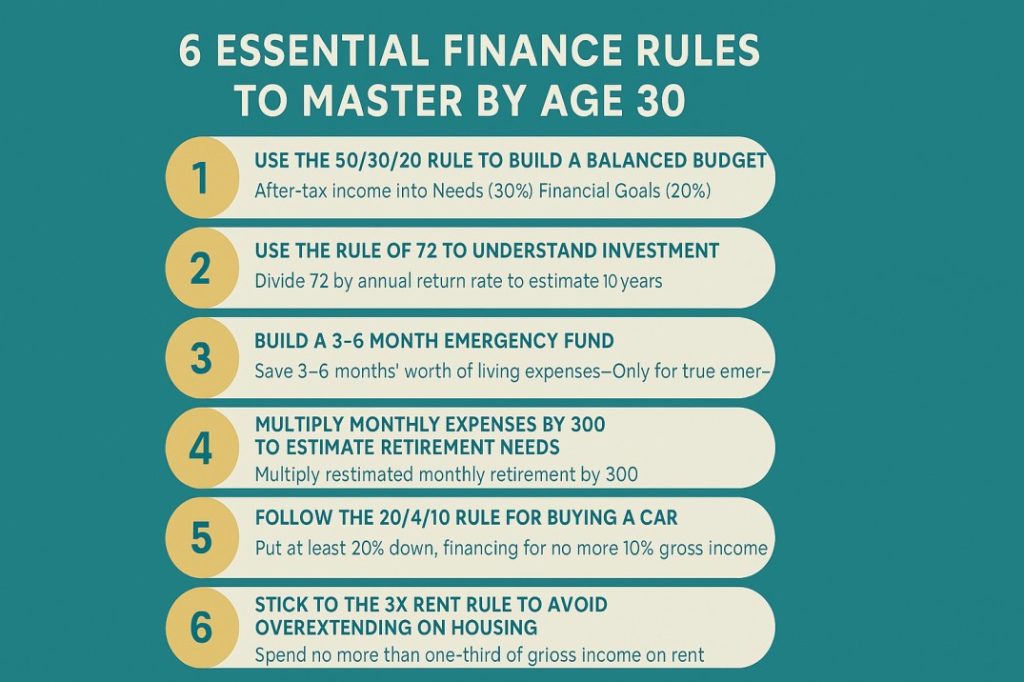
Navigating personal finance in your 20s can be a mix of trial and error—but by the time you hit 30, having a few solid money principles in place can make all the difference. These six timeless rules are practical, easy to understand, and powerful when applied consistently. Whether you’re just starting your career or already climbing the ladder, these tips will help you budget wisely, grow wealth, and steer clear of financial stress.
Let’s break it down.
1. Use the 50/30/20 Rule to Build a Balanced Budget
One of the simplest ways to manage your money is by breaking down your take-home (after-tax) income into three categories:
- 50% for Needs – Essentials like rent, utilities, groceries, transportation, and minimum debt payments.
- 30% for Wants – Lifestyle choices such as dining out, streaming subscriptions, hobbies, travel, or new clothes.
- 20% for Financial Goals – Savings, investments, retirement contributions, and extra debt payments.
This approach makes budgeting less rigid and more sustainable. Let’s say you earn $4,000 per month after taxes. Here’s how your budget could look:
- $2,000 for needs
- $1,200 for wants
- $800 toward savings or debt reduction
By sticking to this ratio, you’re not only covering today’s costs but also planning ahead—and that’s key for long-term financial wellness.
2. Use the Rule of 72 to Understand Investment Growth
Want a quick way to estimate how long it’ll take for your investments to double? The Rule of 72 is your friend.
Just divide 72 by your annual return rate (as a percentage):
- At 8% annual return → 72 ÷ 8 = 9 years
- At 6% return → 72 ÷ 6 = 12 years
This rule illustrates the power of compound interest. The earlier you start investing, the more time your money has to grow. Even small contributions can snowball over time—thanks to this quiet but powerful force.
3. Build a 3–6 Month Emergency Fund
Life happens. Jobs change. Cars break down. Unexpected medical bills appear.
That’s why financial experts recommend setting aside 3 to 6 months’ worth of living expenses in an emergency fund. This fund acts as a financial buffer so you don’t have to rely on credit cards or loans when things go sideways.
If your monthly expenses total $2,500, aim to save between $7,500 and $15,000 in a high-yield savings account or money market fund.
🔑 Pro tip: Only use this fund for true emergencies—not for vacations or last-minute concert tickets.
4. Multiply Monthly Expenses by 300 to Estimate Retirement Needs
Planning for retirement might feel far off, but now is the perfect time to start.
A quick way to estimate how much you’ll need in your retirement nest egg is the 300 Rule. Multiply your current monthly expenses by 300.
For example, if you expect to spend $3,000/month in retirement:
- 3,000 × 300 = $900,000
This rule is based on the 4% safe withdrawal rate, which suggests you can safely withdraw 4% of your savings each year without running out of money.
The key takeaway? The sooner you start contributing to retirement accounts (like a 401(k), IRA, or Roth IRA), the easier it will be to reach that goal—thanks again to compound growth.
5. Follow the 20/4/10 Rule for Buying a Car
Cars are depreciating assets—meaning they lose value over time—so it’s wise not to overspend. The 20/4/10 Rule helps you keep car costs in check:
- Put at least 20% down on the purchase price
- Finance the car for no more than 4 years
- Keep total monthly vehicle expenses (loan + insurance) under 10% of your gross income
Let’s say you’re eyeing a $30,000 car:
- Make a $6,000 down payment
- Finance the remaining over 4 years
- Ensure the monthly payments (plus insurance) stay under $300 if you earn $36,000/year
Following this rule helps prevent you from becoming “car poor,” where vehicle costs eat up too much of your budget.
6. Stick to the 3x Rent Rule to Avoid Overextending on Housing
Housing is likely your biggest monthly expense—so it’s crucial to keep it reasonable. A general guideline is to spend no more than one-third of your gross income on rent.
If your gross monthly income is $4,500, your rent should ideally be $1,500 or less.
If rent prices are steep in your area, consider creative alternatives: get a roommate, explore co-living spaces, or opt for a smaller apartment. Keeping housing costs in check leaves more room in your budget for saving and living comfortably.
Final Thoughts: Make These Rules Work for You
These six financial rules aren’t one-size-fits-all laws—but they are proven, flexible guidelines to help you build a stable financial future. Think of them as the GPS for your money: guiding your decisions, helping you stay on track, and adjusting as your life evolves.
You don’t have to master everything at once. Start by reviewing your budget, setting up an emergency fund, or automating a small monthly investment. Over time, these small steps will turn into powerful habits that lead to long-term success.
💡 Remember: The best time to start was yesterday. The second-best time is today.
- #BudgetingTips
- #EmergencyFund
- #Investing101
- #CompoundInterest
- #RuleOf72
- #RetirementPlanning
- #4PercentRule
- #CarBuyingTips
- #HousingCosts
- #50_30_20Rule